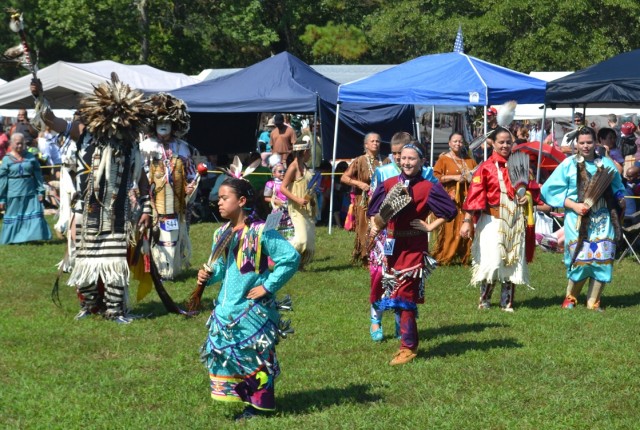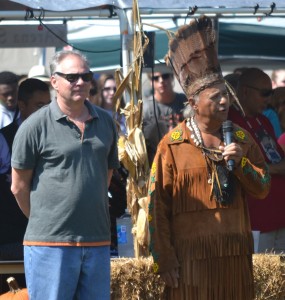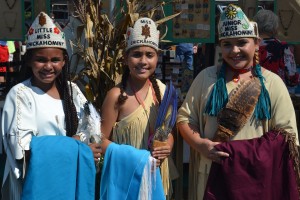Education, heritage focal points of 65th rendition of Chickahominy Fall Festival

A number of tribes unite for the intertribal dance as part of the 65th annual Chickahominy Festival held on Sept. 24 in Charles City. The presentation by the adjoining parties featured a blend of traditional and fancy dancers from tribes around Virginia and the United States.Andre' Jones photos
As at least 1,500 people walked onto the tribal grounds on Sept. 24, the Chickahominy Fall Festival continues to be a draw to guests and tourists from around the United States and the world.
But the 65th rendition of the annual event also garnered the opportunity for attendees to be educated and learn the meaning of the gathering.
An interview with Chickahominy Chief Stephen Adkins, First Asst. Chief Wayne Adkins, and Second Asst. Chief Reggie Stewart provided insight a history and mechanics that makes the event the largest attended gathering in Charles City each year.
“There are a lot of factors and dynamics that have become a part of this festival,” said Chief Adkins. “The history of the indigenous people needed to be told. The tenure of this event would have been even longer if it wasn’t for the wars.”
Adkins spoke about the Racial Integrity Act and how it segregated the contributions of Virginia Indian tribes and the personal effects it had on the Chickahominy culture.
“Virginia took the harsher load when that act was passed,” the chief continued. “It basically wiped us out on paper and out of history books.”
“But we would not let the power of the pen define us,” Adkins added. “What we learn through teaching and oral history are passed down to our younger generations. We teach them our traditions and we use to get together at churches. Tribes use to meet on the banks on what now is Chickahominy Lake and share stories.”
The assistant chiefs weighed into the conversation, speaking on keeping the traditions and heritage of their culture while understanding the changing dynamics of today’s society.
“The powwow and festival has had numerous locations,” said Stewart, pointing to the days it was held in front of the old Charles City Primary School and at one point in Jamestown. “We have faced a lot of hurdles and issues in our society and it speaks volumes that folks continue to come out and support the tribe and we have stuck with it.”
“The roots of our tradition and powwow extend far beyond the days of the colonists,” chimed in Wayne Adkins. “The festival originated when the harvest was done and food had been stored up for the winter. A feast and dance was held to give thanks to the Creator for all he’s done.”
The powwow has become a main draw for Charles City. Dignitaries including local government officials and even vice-presidential candidate Tim Kaine attended this year’s event. But while many of those who visit come to enjoy the music, dancing, and festivities, the number one goal among tribe members is to educate those who have been misinformed about the Native American culture.
“We want people to learn who we are and understand our history,” Stewart said. “I think it’s important to understand where we come from. No matter what culture you are or what background you have, we need to appreciate our ancestors and see the sacrifices they made.
“By having the public come out, we let them know there are Indians in Virginia,” the second assistant chief continued. “Believe it or not there are people who don’t believe Indians are in Virginia. A lot of our history is not in the educational system and not a lot gets out. By having this festival, we have continued with our culture and tradition and we show how proud we are of it.”
“This is primarily an educational event,” chimed in Wayne Adkins. “Yes it’s entertaining and we want everyone to have a good time and there are so many tribes and each one varies and has their own variation on dances and interpretations.”
“When most people think of Indians they think about what’s depicted on movies and television,” Stewart interjected. “They think that all Indians live on reservations or like gambling. What we want to do is pass the message that Indians have lived in different climates and atmospheres and what they did to survive varies from place to place.”
Chief Stephen Adkins became emotional when it came to breaking the mold that society presents when it came to the culture and how the festival is one of the outlets the tribe uses to tell the story to the public.
“There have been several misconceptions about us presented,” the chief said. “This powwow allows us to tell the story that has long been left out of history books, especially those that focus on Virginia history.
“As time progressed, a lot of our heritage was lost in society when schools were integrated,” he continued passionately. “If you ask a person what the average American looks like, the wouldn’t describe somebody like us. This festival allows everybody to see that we work in society like them, but at the same time, we make a deliberate effort to maintain our heritage and culture to make sure we don’t lose it.”
“Our powwow was a bright light on a bright day,” added Wayne Adkins, mentioning the difficulties for those of Native American ancestry to display it publicly. “At one point it was dangerous and illegal for us to display that heritage but on that one day we had our festival, those from our tribes and others would come here and proudly show the world who we are.”
“We are the ones telling our own story,” Stewart commented. “That is what this festival is for; to tell our story to the public.”
Those stories are told through a variation of dances, drumming, and even face-to-face interaction with tribal members. Each part of the festival from the grand entry to the variation of songs and dances play an important role when speaking on the tribe’s history.
“There are various categories of dance and there are specific dances for specific reasons,” commented Wayne Adkins. “Some of those dances stay within the confines of our culture (traditional) while others are modern (fancy).
“One thing that we can say is that we learn a lot of things by interacting with other tribes,” the first assistant chief continued. “Our rabbit dance may be different from another tribes’ rabbit dance but there are parts that we may take from it. It’s the way our culture learns and we adopt it to our culture.”
When looking at close to 2,000 people attending the yearly event, the logistics of the festival seem even more amazing. Preparations for the event began in May about the festival, with decisions rendered by the powwow committee.
“There are a lot of moving arts when we put the framework together to cover all basis,” said Stewart, who was a part of the committee. “Anything from arts and craft vendors, food booths, getting out contracts, the arena staff, there is a lot of maintenance that goes onto the event.
“Even down to getting a dumpster for trash, restrooms, transportation, security, and medical takes a lot of work,” he continued. “Just like any part of life, we learn from our mistakes and have debriefing meetings at the conclusion of the festival.”
“There are so many things people don’t see when it comes to putting this together,” chimed in Wayne Adkins. “Even small things such as ground maintenance, cleaning booths, and coordinating with local authorities are thought of during this process.”
While the trio thanked the rescue squad, local law enforcement, and emergency medical trainers who attend the event, there was a specific group that stood out by far.
“It’s our volunteers,” the group said in a nearly identical tone.
“We have absolutely no paid workers and there are several people who help us with this,” said Wayne Adkins. “It’s almost a disadvantage because people will come and volunteer to help and they already know what booth they are going to be in or what they will be doing. When we do get extra workers, there are times we don’t know where they are going to be.”
And those workers were out in full force Saturday afternoon. At least 100 could be seen trekking the grounds. Besides manning concession stands to keep patrons cool, others volunteers helped with parking vehicles, transporting visitors via golf carts to the grounds, security, setting up canopies and chairs for the elderly, and handing out water.
This particular festival, however, came with a lot of good news. In early September, it was announced that two bills have reach the floor of the House of Representatives and the United States Senate to garner federal recognition to five Native American Tribes. Among those names included the Chickahominy.
“We’ve been to this level before but this time and more significantly, our bill has been marked up (in priority),” said Chief Adkins. “I went to the hearing of the bill and it was the most bi-partisan support we have ever gotten.
“I want to thank Rob Wittman, Bobby Scott, and Senator Kaine for their efforts,” the chief continued. “When people read the bill and look at the treatment, they can’t believe we were treated the way we were. Just because it was lawful doesn’t mean it’s ethical.”
Current Virginia Senator and vice-presidential candidate Kaine provided comments on the 25-year journey to have the tribes federally recognized.
“When I met Chief Adkins in 1991 and learned about the situation involving federal recognition, I worked on it,” commented the senator. “When I got to be governor, I continued to work with Chief Adkins to resolve the issue.
“This year, we finally got the Pamunkey Tribe recognized federally,” Kaine continued. “The reason that happened is because all the tribes help each other. I thought about leaving politics but this is something I have worked on and I believe it was a sense of unfinished business not to get this done.
“It is a slow progress but it gives us hope,” Kaine added as he wrapped up our comment. “This is the closest we have ever been with both bills on the floor but we have to keep pushing.”
Chief Adkins said he has garnered support from federal recognition from the NCAI (National Congress of Indians), CNHI (Council of Native Hawaiian Indians), and AFN (Alaskan Federation of Natives), all organizations that he has personally met with himself. But the chief concluded that some of the strongest support he receives comes from the festival.
“You look at our festival and we have at least 30 tribes represented,” Chief Adkins said. “We have support from different tribes, different cultures, and people around the world. This gathering is just a testament of how our story is being told and I hope people are starting to understand that we are proud of our heritage and thankful to our ancestors who have paved the way for us to accomplish our 65th gathering and celebration.”

Chickahominy Chief Stephen Adkins (right) is accompanied by Virginia Senator and Vice-Presidential candidate Tim Kaine (left) during the opening of the 65th annual powwow.

Representing the Chickahominy Tribe this year are (l to r) Little Miss Chickahominy Kristiana Delaney, Miss Chickahominy Rachel Tupponce, and Junior Miss Chickahominy Brooke Adams.

